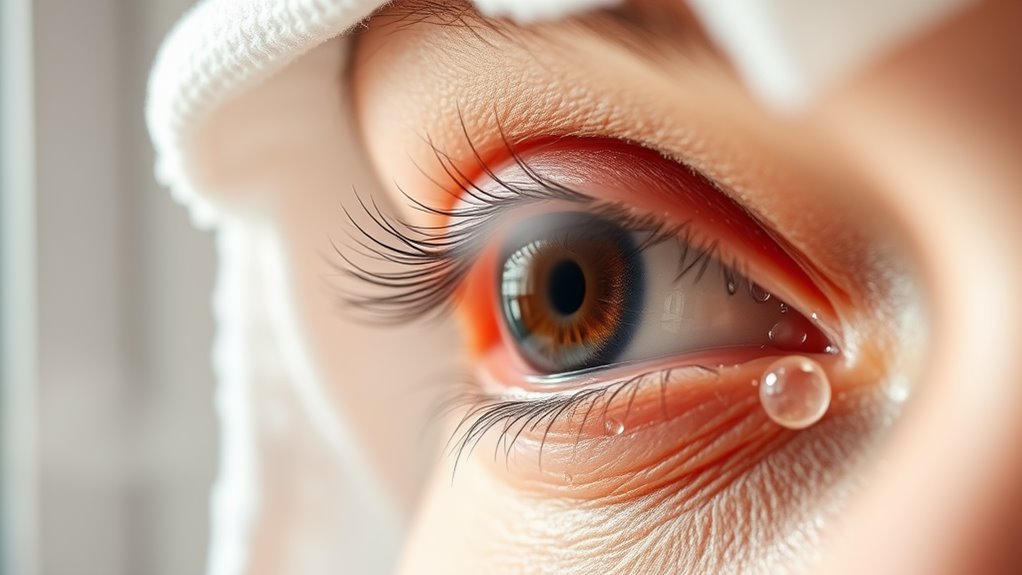The Fastest Way to Clear Up a Stubborn Stye!
To clear up a stubborn stye quickly, apply a warm compress to the affected eye for 10-15 minutes, four times daily. Clean your eyelids gently with baby shampoo and warm water using a cotton swab. You can also try used tea bags as a natural anti-inflammatory compress. Avoid wearing eye makeup and switch to glasses until it heals. For faster relief, over-the-counter pain relievers can help with discomfort. Learn more effective treatments and prevention tips below.
What Causes a Stubborn Stye?
When bacteria build up in your eyelash follicles or oil glands, a painful, swollen bump called a stye can develop. While you’re looking for stye remedies fast, it’s important to understand what’s making yours stick around longer than usual. Poor eye hygiene is often the main culprit, especially if you’re not removing eye makeup thoroughly or touching your eyes with unwashed hands.
Your stye might be stubborn because of underlying conditions like blepharitis, an inflammation of the eyelids, or rosacea. Stress and lack of sleep can weaken your immune system, making it harder for your body to fight the infection.
If you wear contact lenses, improper cleaning or wearing them for too long can trap bacteria against your eye. Hormonal changes and certain medications that affect your oil glands may also contribute to recurring styes.
Sometimes, what seems like a persistent stye could actually be a chalazion, which requires different treatment approaches.
Common Symptoms and Warning Signs
A stye’s telltale signs typically appear within a day or two of infection.
You’ll notice a small, red bump forming along your eyelid that becomes increasingly tender to touch. The affected area often feels like there’s something stuck in your eye, making it uncomfortable to blink.
Watch for these warning signs that indicate you’re dealing with a stye:
- A painful, pimple-like bump on your upper or lower eyelid that’s red and swollen
- Excessive tearing and a scratchy sensation when you blink or move your eye
- Crusting around the eyelids, especially in the morning after waking up
- Light sensitivity and mild blurring of vision in the affected eye
If you notice the swelling spreading beyond your eyelid or experience fever and chills, you’ll need to seek immediate medical attention, as these symptoms might indicate a more serious infection requiring professional treatment.
Quick-Acting Home Remedies
Treating a stye at home can bring quick relief while the infection runs its course.
You’ll want to start with a warm compress, which you can make by soaking a clean washcloth in hot water. Apply it to your eye for 10-15 minutes, four times daily. This helps bring the stye to a head and encourages natural drainage.
Keep your hands clean and avoid touching or rubbing your eye. You can gently clean your eyelids with baby shampoo mixed with warm water, using a cotton swab.
Many people find that a used tea bag (green or black tea) works well as a compress, as it contains natural anti-inflammatory properties.
Over-the-counter pain relievers can help with discomfort, and artificial tears can soothe irritation.
Remember not to wear eye makeup until the stye heals, and if you wear contacts, switch to glasses temporarily to prevent further irritation.
Medical Treatment Options
Though most styes clear up with home remedies, persistent ones may require medical intervention.
If your stye hasn’t improved after a week of home treatment, it’s time to visit your eye doctor, who’ll recommend the most appropriate medical solution for your situation.
Your doctor might suggest one of these proven treatments to help you get back to feeling confident and comfortable:
- Prescription antibiotic eye drops or ointments to fight the infection and reduce inflammation that’s making your eye uncomfortable
- Professional drainage procedure where the doctor safely opens the stye to release trapped pus and speed up healing
- Steroid injections to quickly reduce severe swelling and discomfort in stubborn cases
- Minor surgery under local anesthetic to remove particularly large or recurring styes that won’t respond to other treatments
Essential Prevention Tips
Always wash your hands before touching your eyes or removing contact lenses. Keep your eye makeup fresh by replacing it every three months, and never share cosmetics with others. Remove all eye makeup before bed using gentle, oil-free removers. If you wear contact lenses, clean them properly and replace them as recommended.
Protect your eyes from dust and debris by wearing protective eyewear when working in dirty environments. Don’t rub your eyes when they’re irritated – instead, use a clean, warm compress for relief. Chronic conditions like blepharitis can increase your risk of developing styes, so it’s essential to manage any underlying issues.
If you frequently get styes, switching to hypoallergenic eye products might help reduce your risk. Remember to keep your pillowcases clean by washing them weekly in hot water.
When to See Your Eye Doctor
Even with proper prevention, some styes require professional medical attention. When you’ve tried home remedies for 48 hours with no improvement, it’s time to consult an eye doctor.
You’ll want to reach out to your doctor immediately if you’re experiencing any concerning symptoms.
Contact your eye care provider if you notice:
- Vision changes or blurriness that wasn’t there before the stye appeared
- Severe pain that extends beyond your eyelid to other parts of your face
- Redness that spreads across your entire eyelid or to other areas around your eye
- A stye that bleeds, releases pus, or hasn’t shown improvement after two weeks
These symptoms could indicate a more serious condition that needs specialized treatment.
Your eye doctor can properly diagnose the issue and may prescribe antibiotics or recommend minor surgery if necessary.
Don’t hesitate to seek help – protecting your eye health is crucial.




